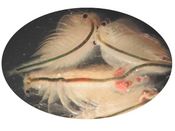| Brine shrimp |

Artemia salina
|
|
Scientific classification |
| Kingdom: |
Animalia
|
| Phylum: |
Arthropoda
|
| Subphylum: |
Crustacea
|
| Class: |
Branchiopoda
|
| Order: |
Anostraca
|
| Family: |
Artemiidae
Grochowski, 1896 |
| Genus: |
Artemia
Leach, 1819 |
|
| Species |
Artemia franciscana
Artemia gracilis
Artemia monica
Artemia nyos
Artemia parartemia
Artemia parthenogenetica
Artemia persimilis
Artemia pollicaris
Artemia salina
Artemia sinica
Artemia tibetiana
Artemia tunesiana
Artemia urmiana
|
Brine shrimp (Artemia) are a type of
aquatic
crustacean. They are found worldwide in saltwater, though
not in oceans. Artemia is a well known genus as one variety,
the Artemia nyos, a hybrid of Artemia salina, are sold as
novelty gifts, most commonly under the marketing name
Sea-Monkeys.
Artemia were first discovered in Lymington,
England in 1755. There are mixed views on whether all
brine shrimp are part of one species or whether the
varieties that have been identified are properly classified
as separate species.
Un-hatched brine shrimp are metabolically inactive and
can remain in total stasis for several years while in dry
oxygen-free conditions, even at temperatures below freezing.
This characteristic is called Cryptobiosis meaning "hidden
life" (also called Diapause). Once placed in water, the
cyst-like eggs hatch within a few hours, and will grow to a
mature length of around one centimeter on average. Brine
shrimp have a biological life cycle of one year. This short
life span, and other characteristics such as their ability
to remain dormant for long periods, have made them
invaluable in scientific research, including space
experiments.
Brine shrimp can tolerate varying levels of
salinity, and a common biology experiment in school is
to investigate the effect of salinity levels on the growth
of these creatures. Also, because they have no brain and a
very crude nervous/spinal system, they can be used for many
experiments without having to worry about animal ethics.
The nutritional properties of newly hatched brine shrimp
make them particularly suitable to be sold as
aquarium food as they are high in lipids and unsaturated
fatty acids (but low in calcium). These nutritional benefits are likely to be
one reason that brine shrimp are found only in highly salinated waters, as these areas are uninhabitable for
potential predators.
The
nauplii, or larvae, of brine shrimp are less than 500
micrometers when they first hatch. They eat micro-algae, but
will also eat yeast, wheat flour, soybean powder, or egg
yolk.
Artemia monica, the variety commonly known as Mono
Lake brine shrimp, are found only in
Mono Lake, Mono County, California. In 1987, Dr. Dennis D.
Murphy from Stanford University petitioned the United States
Fish and Wildlife Service to add Artemia monica to the
endangered species list under the Endangered Species Act
1973. Despite there being trillions of these creatures in
Mono Lake, it was felt that rising levels of salinity and
sodium hydroxide concentration of the lake would endanger
them because of the increase in pH. However, the US Fish and
Wildlife Service reported in the Federal Register on 7
September 1995 that this brine shrimp did not warrant listing
after the threat to the lake was removed following a revised
policy by the California State Water Resources Control Board
[1].
External links




